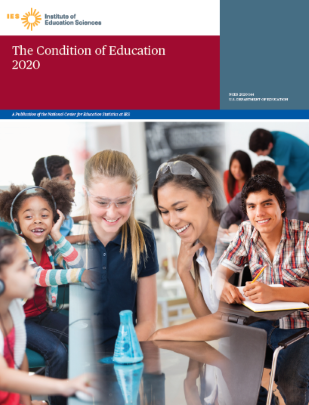NCES is pleased to present The Condition of Education 2020, an annual report mandated by the U.S. Congress that summarizes the latest data on education in the United States. This report uses data from across the center and from other sources and is designed to help policymakers and the public monitor educational progress. This year’s report includes 47 indicators on topics ranging from prekindergarten through postsecondary education, as well as labor force outcomes and international comparisons.

The data show that 50.7 million students were enrolled in public elementary and secondary schools (prekindergarten through grade 12) and approximately 5.7 million students were enrolled in private elementary and secondary schools in fall 2017, the most recent year for which data were available. In school year 2017–18, some 85 percent of public high school students graduated on time with a regular diploma. This rate was similar to the previous year’s rate. About 2.2 million, or 69 percent, of those who completed high school in 2018, enrolled in college that fall. Meanwhile, the status dropout rate, or the percentage of 16- to 24-year-olds who were not enrolled in school and did not have a high school diploma or its equivalent, was 5.3 percent in 2018.
Total undergraduate enrollment in degree-granting postsecondary institutions in 2018 stood at 16.6 million students. The average net price of college for first-time, full-time undergraduates attending 4-year institutions was $13,700 at public institutions, $27,000 at private nonprofit institutions, and $22,100 at private for-profit institutions (in constant 2018–19 dollars). In the same year, institutions awarded 1.0 million associate’s degrees, 2.0 million bachelor’s degrees, 820,000 master’s degrees, and 184,000 doctor’s degrees.
Ninety-two percent of 25- to 34-year-olds in the United States had a high school diploma or its equivalent in 2018. In comparison, the average rate for the Organization for Economic Cooperation and Development (OECD) member countries was 85 percent. Some 49 percent of these individuals in the United States had obtained a postsecondary degree, compared with the OECD average of 44 percent. Similar to previous years, annual median earnings in 2018 were higher for 25- to 34-year-olds with higher levels of education. In 2018, U.S. 25- to 34-year-olds with a bachelor’s or higher degree earned 66 percent more than those with a high school diploma or equivalent.
The Condition of Education includes an Executive Summary, an At a Glance section, a Reader’s Guide, a Glossary, and a Guide to Sources, all of which provide additional background information. Each indicator includes references to the source data tables used to produce the indicator.
As new data are released throughout the year, indicators will be updated and made available on The Condition of Education website.
In addition to publishing The Condition of Education, NCES produces a wide range of other reports and datasets designed to help inform policymakers and the public about significant trends and topics in education. More information about the latest activities and releases at NCES may be found on our website or at our social media sites on Twitter, Facebook, and LinkedIn.
By James L. Woodworth, NCES Commissioner